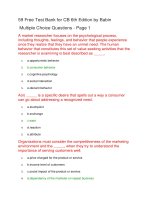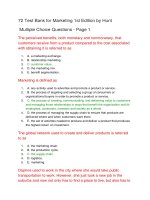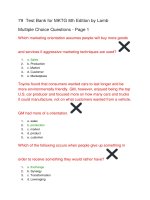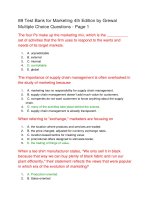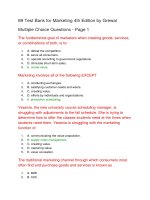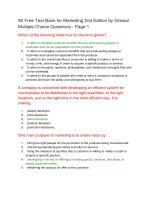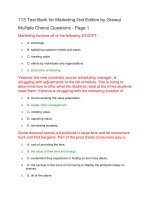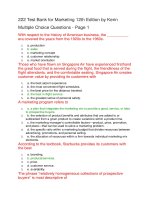Test bank for microeconomics 11th edition by stephen l slavin
Bạn đang xem bản rút gọn của tài liệu. Xem và tải ngay bản đầy đủ của tài liệu tại đây (5.44 MB, 242 trang )
Link full download:
/>
Test Bank for Microeconomics 11th Edition by
Stephen L Slavin
Chapter 02
Resource Utilization
Multiple Choice Questions
1.
The United States economy ______________ operates on its production possibility curve.
A. Always
B. Sometimes
C. Never
2.
Which statement is true?
A. Entrepreneurial ability is in short supply in the U.S.
B. Land, labor and capital may be considered passive resources.
C. The concept of opportunity cost is irrelevant when there is scarcity.
D. None of these statements are true.
3.
In the United States' economy
A. there is no need to economize.
B. we rarely have to economize.
C. only the rich have to economize.
D. nearly everyone has to economize.
2-1
Copyright © 2014 McGraw-Hill Education. All rights reserved. No reproduction or distribution without the prior written consent of
McGraw-Hill Education.
4.
The term "the affluent society" was coined by
A. Michael Harrington.
B. John Kenneth Galbraith.
C. Karl Marx.
D. Adam Smith.
5.
Each of the following is an example of an economic resource except
A. land.
B. money.
C. capital.
D. labor.
6.
The United States' economy would be operating at full employment with labor unemployment rate of ___
percent and a capacity utilization rate of _____ percent.
A. 5; 95
B. 5; 85
C. 10; 95
D. 10; 85
7.
Which statement is true?
A. On the production possibilities frontier there is zero unemployment.
B. On the production possibilities frontier 95 percent of the labor force is employed.
C. To get out of a recession, we must produce at some point beyond our production possibilities frontier.
D. To have economic growth, we must push the production possibilities frontier inward.
2-2
Copyright © 2014 McGraw-Hill Education. All rights reserved. No reproduction or distribution without the prior written consent of
McGraw-Hill Education.
8.
In order to raise the rate of economic growth we would need to
A. increase the level of capital.
B. reduce the level of labor.
C. spend more on military goods.
D. spend more on consumer goods.
9.
The main reason the United States' standard of living is higher than that of India and China is that we
have more
A. land.
B. labor.
C. capital.
D. money.
10. Which statement is true?
A. it is easier to attain full employment than full production.
B. employment discrimination no longer exists in the U.S. labor market.
C. The United States is usually operating on the production possibilities frontier.
D. None of these statements are true.
11. The main effect of employment discrimination is
A. Unemployment.
B. Underemployment.
C. Greater efficiency.
D. Greater production.
2-3
Copyright © 2014 McGraw-Hill Education. All rights reserved. No reproduction or distribution without the prior written consent of
McGraw-Hill Education.
12. The United States temporarily operated outside the production possibilities frontier in
A. 1933.
B. 1943.
C. 1973.
D. 1982.
13. Which statement is true?
A. The economic problem is limited to poverty.
B. Scarcity is no longer an economic problem in the United States.
C. If we all had more money there would be less scarcity.
D. None of these statements are true.
14. Which statement is true?
A. The United States is usually inside our production possibilities curve.
B. The United States is usually outside our production possibilities curve.
C. The United States is usually on our production possibilities curve.
D. None of the statements are true.
2-4
Copyright © 2014 McGraw-Hill Education. All rights reserved. No reproduction or distribution without the prior written consent of
McGraw-Hill Education.
15.
Which movement between two points represents economic growth?
A. J to K
B. K to L
C. L to M
D. M to N
2-5
Copyright © 2014 McGraw-Hill Education. All rights reserved. No reproduction or distribution without the prior written consent of
McGraw-Hill Education.
16.
Assuming the inner curve is the United States' current production possibilities frontier, the United States'
economy usually operates at _____.
A. Point P
B. Point O
C. Point N
D. Point L
2-6
Copyright © 2014 McGraw-Hill Education. All rights reserved. No reproduction or distribution without the prior written consent of
McGraw-Hill Education.
17.
Assuming the inner curve is the United States' current production possibilities frontier, points J, N and K
represent
A. an inefficient use of resources.
B. an output that is not possible to produce.
C. points of unemployed resources.
D. points of fully employed resources.
2-7
Copyright © 2014 McGraw-Hill Education. All rights reserved. No reproduction or distribution without the prior written consent of
McGraw-Hill Education.
18.
Assuming the inner curve is the United States' current production possibilities frontier, which of the
following points would eventually lead to the greatest level of economic growth?
A. Point J
B. Point N
C. Point K
D. Point P
2-8
Copyright © 2014 McGraw-Hill Education. All rights reserved. No reproduction or distribution without the prior written consent of
McGraw-Hill Education.
19.
A movement from point J to point M would represent
A. an increase in consumer goods, but not capital goods.
B. an increase in capital goods, but not consumer goods.
C. an increase in both capital goods and consumer goods.
D. no increase in either capital goods or consumer goods.
2-9
Copyright © 2014 McGraw-Hill Education. All rights reserved. No reproduction or distribution without the prior written consent of
McGraw-Hill Education.
20.
A movement from point N to point L would represent
A. an increase in both consumer goods and capital goods.
B. a decrease in both consumer goods and capital goods.
C. an increase in consumer goods, but a decrease in capital goods.
D. an increase in capital goods, but a decrease in consumer goods.
2-10
Copyright © 2014 McGraw-Hill Education. All rights reserved. No reproduction or distribution without the prior written consent of
McGraw-Hill Education.
21.
The opportunity cost of a movement from point N to J would
A. be the lost production of some capital goods.
B. be the lost production of some consumer goods.
C. be slower economic growth in the future.
D. not involve any sacrifice of either capital or consumer goods.
22. If a nation is currently operating at a point inside its production possibilities curve, it
A. can increase the output of one good without decreasing the output of the other good.
B. has fully employed resources.
C. has no inefficiently employed resources.
D. is operating at full potential.
23. Which of the following is not demonstrated by a production possibility curve?
A. scarcity
B. opportunity cost
C. necessity for choice due to scarcity
D. price
2-11
Copyright © 2014 McGraw-Hill Education. All rights reserved. No reproduction or distribution without the prior written consent of
McGraw-Hill Education.
24. People are forced to economize because of
A. competition.
B. pressure to conform.
C. scarcity.
D. the absence of money.
25. The United States' basic economic problem would be solved if
A. everyone were given $500,000.
B. the population stopped growing.
C. all sickness and disease were wiped out.
D. our wants could be satisfied with available resources.
26. If the economy is operating at a 7 percent unemployment rate we are operating
A. inside the production possibilities curve.
B. on the production possibilities curve.
C. outside the production possibilities curve.
2-12
Copyright © 2014 McGraw-Hill Education. All rights reserved. No reproduction or distribution without the prior written consent of
McGraw-Hill Education.
27.
In 1939 the U.S. economy was operating at point ________.
A. A
B. B
C. C
D. D
2-13
Copyright © 2014 McGraw-Hill Education. All rights reserved. No reproduction or distribution without the prior written consent of
McGraw-Hill Education.
28.
In 1944 the U.S. economy was temporarily operating at point _________.
A. A
B. B
C. C
D. D
29. We can increase the United States' rate of economic growth by
A. devoting more output to capital goods.
B. devoting more output to improving our technology.
C. devoting more output to improving the quality of our labor force.
D. all of the choices are true.
30. If an assumption is made that a society is operating on its production possibilities curve, an outward shift of
the curve implies
A. economic growth has occurred.
B. the society is making more efficient use of its available resources.
C. consumer demand has increased.
D. the present value of capital resources has increased.
2-14
Copyright © 2014 McGraw-Hill Education. All rights reserved. No reproduction or distribution without the prior written consent of
McGraw-Hill Education.
31. Resources include
A. land, labor and money.
B. entrepreneurship and capital.
C. capital and money.
D. corporations and partnerships.
32. The study of economics
A. is a very narrow endeavor.
B. is a way of analyzing decision-making processes caused by scarcity.
C. focuses on how a business should function.
D. is concerned with proving that capitalism is better than socialism.
33. Economic growth can be shown by ____________________ production possibilities curve.
A. an outward shift of the
B. an inward shift of the
C. a movement from one point to another along the
D. a movement to a point inside the
34. Economic growth is difficult for poor countries because
A. governments must fund capital production and research out of tax revenues.
B. resources must be taken away from consumer goods to pay for capital goods.
C. those wealthy enough to invest in domestic industries may choose to invest abroad instead.
D. All of the choices are true.
2-15
Copyright © 2014 McGraw-Hill Education. All rights reserved. No reproduction or distribution without the prior written consent of
McGraw-Hill Education.
35. The United States economy is generally operating _________ the production possibilities curve.
A. inside
B. outside
C. on
36. Economic growth occurs when
A. a large part of a country's population is poor.
B. a society sacrifices an amount of one good for more of another along its production possibility frontier.
C. a society acquires additional resources or when its technology advances.
D. there is unemployment of labor but other resources are used efficiently.
37. If you own a building and you decide to use that building to open a restaurant,
A. there are no sunk costs involved in this decision.
B. there is no opportunity cost of using this building for a restaurant because you own it.
C. the only cost relevant to this decision is the price you paid for the building.
D. there is an opportunity cost of using this building for a restaurant because it could have been used in
other ways.
38. Which of the following is an example of opportunity cost?
A. The income that could have been earned by working full-time instead of going to college.
B. The decline in the grades of a student athlete that occurs because she decides to spend more time
practicing sports than on her academic work.
C. The value of other things you could have done with the same time and money it cost you to go to the
movies.
D. All of the choices are examples of opportunity cost.
2-16
Copyright © 2014 McGraw-Hill Education. All rights reserved. No reproduction or distribution without the prior written consent of
McGraw-Hill Education.
39. The opportunity cost for a student of attending college for a year is measured by
A. the benefit received by the student.
B. the tuition paid for the year.
C. the value of the most valued opportunity foregone by attending college.
D. the total money outlays associated with attending college.
40. The economic problem is essentially one of deciding how to make the best use of
A. limited resources to satisfy limited wants.
B. unlimited resources to satisfy limited wants.
C. limited resources to satisfy unlimited wants.
D. unlimited resources to satisfy unlimited wants.
41. Jeff's entertainment budget is divided between $8 movie tickets and $40 hockey tickets. The
opportunity cost to Jeff of going to an extra hockey game is
A. four fewer $10 pizzas.
B. five movies.
C. 20 DVD rentals (costing $2 each).
D. all of the choices are true.
42. An inward shift in the entire production possibilities frontier
A. represents economic growth.
B. means that the economy can produce more of both goods.
C. takes place if there is an expansion in the labor force.
D. means that previous levels of production are now unobtainable.
2-17
Copyright © 2014 McGraw-Hill Education. All rights reserved. No reproduction or distribution without the prior written consent of
McGraw-Hill Education.
43. Entrepreneurship is
A. the financial capital necessary to launch a new business.
B. the talent to develop new products and processes and to organize production to make goods and
services available.
C. unskilled labor.
D. the capital resources used to produce goods and services.
44. Which of the following statements about the concept of opportunity cost is true?
A. The opportunity cost of a decision only includes monetary outlays.
B. The opportunity cost of a decision is the next best foregone alternative.
C. All decisions have zero opportunity cost.
D. The opportunity cost of a college education is measured by the payments for tuition and books.
45. The statement "By the time our grandchildren are born, scarcity will not be a problem" is
A. possible only if technology advances at a great pace.
B. true, because we will learn to limit our wants in the future.
C. true, because by that time everyone's basic needs will be met.
D. false, because people always want more than there is available.
46. The opportunity cost of producing one additional truck is
A. the profit that could have been earned from selling that truck.
B. the amount of other goods that could not be produced because productive resources were used instead to
produce that truck.
C. the price of the truck.
D. all of the choices are true.
2-18
Copyright © 2014 McGraw-Hill Education. All rights reserved. No reproduction or distribution without the prior written consent of
McGraw-Hill Education.
47. The reason that opportunity costs arise is that
A. people have unlimited wants.
B. there are no alternative decisions that could be made.
C. an economy relies on money to facilitate exchange of goods and services.
D. resources are scarce.
48. A small economy produces only pizzas and jeans. If an economy is operating inside its production
possibility frontier, which of the following statements is true?
A. it will be possible to produce more pizzas without decreasing the production of jeans.
B. the economy will be operating at a point on its production possibilities curve.
C. the economy will be operating at a point outside its production possibilities curve.
D. it will not be possible to produce more jeans or pizzas.
49. If an economy is operating on its production possibility frontier, which of the following statements is
true?
A. Products are produced using inefficient production technology.
B. The capacity utilization rate is less than full production.
C. The economy's labor force is fully employed.
D. A fall in the price of an input will enable the economy to produce outside the production
possibility frontier.
50. Which of the following is not a factor of production?
A. Land
B. Money
C. Capital
D. Labor
2-19
Copyright © 2014 McGraw-Hill Education. All rights reserved. No reproduction or distribution without the prior written consent of
McGraw-Hill Education.
51. The existence of unemployment can be illustrated on a production possibilities curve by a(n)
A. point below or inside the surface of the curve.
B. inward shift of the curve.
C. movement along the curve.
D. outward shift of the curve.
52. Which of the following will shift an economy's production possibilities curve outward?
A. An improvement in technology
B. An increase in the unemployment rate
C. A decrease in land, labor or capital
D. A decrease in the unemployment rate
53. The production possibilities curve illustrates the basic principle that
A. an economy's capacity to produce increases in proportion to its population size.
B. if all the resources of an economy are in use, more of one good can be produced only if less of another
good is produced.
C. an economy will automatically seek that level of output at which all of its resources are
employed.
D. the production of more of any one good will in time require smaller and smaller sacrifices of other
goods.
54. A point along a production possibilities curve shows
A. that in order to acquire more of one good, none of the alternative good must be given up.
B. that in order to acquire more of one good, some of the alternative good must be given up.
C. that any amount of goods could be produced by society if people worked harder.
D. various combinations of guns and butter that can be produced under conditions of 6 percent
unemployment.
2-20
Copyright © 2014 McGraw-Hill Education. All rights reserved. No reproduction or distribution without the prior written consent of
McGraw-Hill Education.
55. The production possibilities curve tells us that if full employment exists and a nation wishes to
permanently increase its production of military goods, it must
A. also increase its production of nonmilitary goods.
B. reduce its output of nonmilitary goods.
C. suffer inflation.
D. suffer unemployment.
56.
If the economy was operating at point O (where the two axes come together), we would have an
unemployment rate of ______ percent.
A. 5
B. 50
C. 95
D. 100
2-21
Copyright © 2014 McGraw-Hill Education. All rights reserved. No reproduction or distribution without the prior written consent of
McGraw-Hill Education.
57.
If we were at point ____ it would be possible to produce more heart transplants and more round-theworld trips.
A. P
B. Q
C. R
D. S
2-22
Copyright © 2014 McGraw-Hill Education. All rights reserved. No reproduction or distribution without the prior written consent of
McGraw-Hill Education.
58.
If we are currently at point T, we can get to point S in the long run
A. through economic growth over a period of years.
B. immediately by using resources more efficiently.
C. immediately by reducing the unemployment rate.
D. immediately through technological development.
2-23
Copyright © 2014 McGraw-Hill Education. All rights reserved. No reproduction or distribution without the prior written consent of
McGraw-Hill Education.
59.
We could increase the production of both heart transplants and round-the-world trips if we moved to point
T from point
A. P.
B. Q.
C. R.
D. S.
2-24
Copyright © 2014 McGraw-Hill Education. All rights reserved. No reproduction or distribution without the prior written consent of
McGraw-Hill Education.

